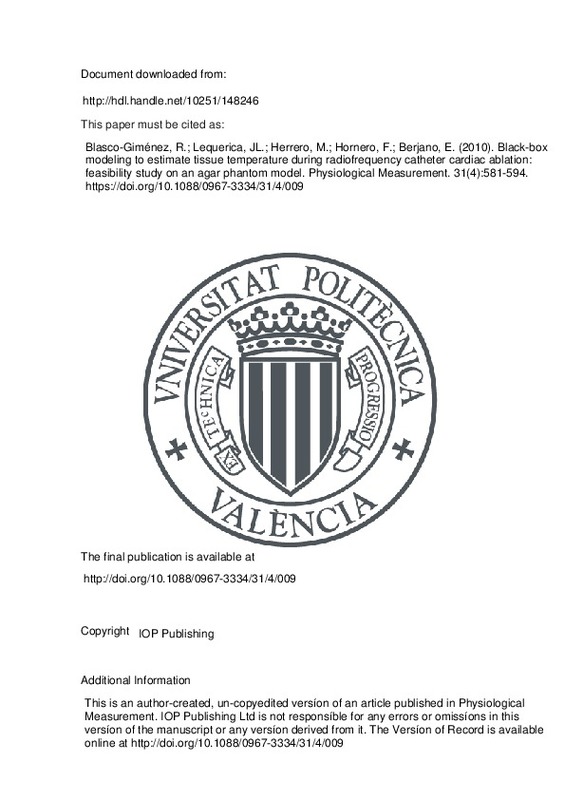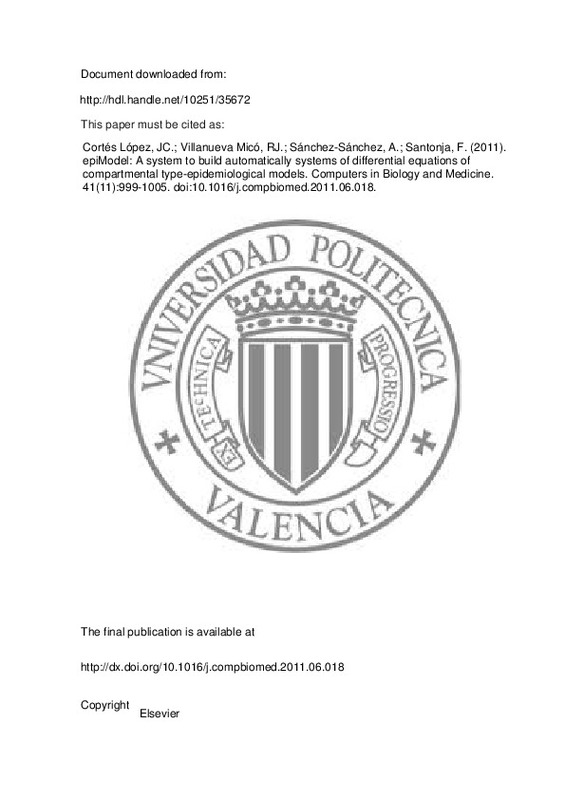JavaScript is disabled for your browser. Some features of this site may not work without it.
Buscar en RiuNet
Listar
Mi cuenta
Estadísticas
Ayuda RiuNet
Admin. UPV
Black-box modeling to estimate tissue temperature during radiofrequency catheter cardiac ablation: feasibility study on an agar phantom model
Mostrar el registro sencillo del ítem
Ficheros en el ítem
| dc.contributor.author | Blasco-Giménez, Ramón
|
es_ES |
| dc.contributor.author | Lequerica, Juan L.
|
es_ES |
| dc.contributor.author | Herrero, María
|
es_ES |
| dc.contributor.author | Hornero, Fernando
|
es_ES |
| dc.contributor.author | Berjano, Enrique
|
es_ES |
| dc.date.accessioned | 2020-07-18T03:31:51Z | |
| dc.date.available | 2020-07-18T03:31:51Z | |
| dc.date.issued | 2010-04 | es_ES |
| dc.identifier.issn | 0967-3334 | es_ES |
| dc.identifier.uri | http://hdl.handle.net/10251/148246 | |
| dc.description | This is an author-created, un-copyedited versíon of an article published in Physiological Measurement. IOP Publishing Ltd is not responsíble for any errors or omissíons in this versíon of the manuscript or any versíon derived from it. The Versíon of Record is available online at http://doi.org/10.1088/0967-3334/31/4/009 | es_ES |
| dc.description.abstract | [EN] The aim of this work was to study linear deterministic models to predict tissue temperature during radiofrequency cardiac ablation (RFCA) by measuring magnitudes such as electrode temperature, power and impedance between active and dispersive electrodes. The concept involves autoregressive models with exogenous input (ARX), which is a particular case of the autoregressive moving average model with exogenous input (ARMAX). The values of the mode parameters were determined from a least-squares fit of experimental data. The data were obtained from radiofrequency ablations conducted on agar models with different contact pressure conditions between electrode and agar (0 and 20 g) and different flow rates around the electrode (1, 1.5 and 2 L min¿1). Half of all the ablations were chosen randomly to be used for identification (i.e. determination of model parameters) and the other half were used for model validation. The results suggest that (1) a linear model can be developed to predict tissue temperature at a depth of 4.5 mm during RF cardiac ablation by using the variables applied power, impedance and electrode temperature; (2) the best model provides a reasonably accurate estimate of tissue temperature with a 60% probability of achieving average errors better than 5 °C; (3) substantial errors (larger than 15 °C) were found only in 6.6% of cases and were associated with abnormal experiments (e.g. those involving the displacement of the ablation electrode) and (4) the impact of measuring impedance on the overall estimate is negligible (around 1 °C). | es_ES |
| dc.description.sponsorship | This work was supported by the 'Plan Nacional de Investigacion Cientifica, Desarrollo e Innovacion Tecnologica del Ministerio de Educacion y Ciencia' of Spain (TEC200801369/ TEC) and by an R&D contract (CSIC-20060633) between Edwards Lifescience Ltd and the Spanish National Research Council (CSIC). The English revision and correction of this paper was funded by the Universidad Politecnica de Valencia, Spain. We thank L Melecio for his invaluable technical support in conducting the experiments. | es_ES |
| dc.language | Inglés | es_ES |
| dc.publisher | IOP Publishing | es_ES |
| dc.relation.ispartof | Physiological Measurement | es_ES |
| dc.rights | Reserva de todos los derechos | es_ES |
| dc.subject | Agar phantom | es_ES |
| dc.subject | Autoregressive modeling | es_ES |
| dc.subject | Black-box modeling | es_ES |
| dc.subject | Cardiac ablation | es_ES |
| dc.subject | Catheter ablation | es_ES |
| dc.subject | Non-structured model | es_ES |
| dc.subject | Temperature prediction | es_ES |
| dc.subject | Radiofrequency ablation | es_ES |
| dc.subject | Temperature measurement | es_ES |
| dc.subject.classification | TECNOLOGIA ELECTRONICA | es_ES |
| dc.subject.classification | INGENIERIA DE SISTEMAS Y AUTOMATICA | es_ES |
| dc.title | Black-box modeling to estimate tissue temperature during radiofrequency catheter cardiac ablation: feasibility study on an agar phantom model | es_ES |
| dc.type | Artículo | es_ES |
| dc.identifier.doi | 10.1088/0967-3334/31/4/009 | es_ES |
| dc.relation.projectID | info:eu-repo/grantAgreement/CSIC//CSIC-20060633/ | es_ES |
| dc.relation.projectID | info:eu-repo/grantAgreement/MICINN//TEC2008-01369/ES/MODELOS COMPUTACIONALES E INVESTIGACION EXPERIMENTAL EN EL ESTUDIO DE TECNICAS QUIRURGICAS DE CALENTAMIENTO DE TEJIDOS BIOLOGICOS MEDIANTE CORRIENTES DE RADIOFRECUENCIA./ | es_ES |
| dc.rights.accessRights | Abierto | es_ES |
| dc.contributor.affiliation | Universitat Politècnica de València. Departamento de Ingeniería de Sistemas y Automática - Departament d'Enginyeria de Sistemes i Automàtica | es_ES |
| dc.contributor.affiliation | Universitat Politècnica de València. Departamento de Ingeniería Electrónica - Departament d'Enginyeria Electrònica | es_ES |
| dc.description.bibliographicCitation | Blasco-Giménez, R.; Lequerica, JL.; Herrero, M.; Hornero, F.; Berjano, E. (2010). Black-box modeling to estimate tissue temperature during radiofrequency catheter cardiac ablation: feasibility study on an agar phantom model. Physiological Measurement. 31(4):581-594. https://doi.org/10.1088/0967-3334/31/4/009 | es_ES |
| dc.description.accrualMethod | S | es_ES |
| dc.relation.publisherversion | http://doi.org/10.1088/0967-3334/31/4/009 | es_ES |
| dc.description.upvformatpinicio | 581 | es_ES |
| dc.description.upvformatpfin | 594 | es_ES |
| dc.type.version | info:eu-repo/semantics/publishedVersion | es_ES |
| dc.description.volume | 31 | es_ES |
| dc.description.issue | 4 | es_ES |
| dc.relation.pasarela | S\39255 | es_ES |
| dc.contributor.funder | Universitat Politècnica de València | es_ES |
| dc.contributor.funder | Consejo Superior de Investigaciones Científicas | es_ES |
| dc.contributor.funder | Ministerio de Ciencia e Innovación | es_ES |
| dc.description.references | Hong Cao, Tungjitkusolmun, S., Young Bin Choy, Jang-Zern Tsai, Vorperian, V. R., & Webster, J. G. (2002). Using electrical impedance to predict catheter-endocardial contact during RF cardiac ablation. IEEE Transactions on Biomedical Engineering, 49(3), 247-253. doi:10.1109/10.983459 | es_ES |
| dc.description.references | Hong Cao, Vorperian, V. R., Jang-Zem Tsai, Tungjitkusolmun, S., Eung Je Woo, & Webster, J. G. (2000). Temperature measurement within myocardium during in vitro RF catheter ablation. IEEE Transactions on Biomedical Engineering, 47(11), 1518-1524. doi:10.1109/10.880104 | es_ES |
| dc.description.references | Hamner, C. E., Potter, D. D., Cho, K. R., Lutterman, A., Francischelli, D., Sundt, T. M., & Schaff, H. V. (2005). Irrigated Radiofrequency Ablation With Transmurality Feedback Reliably Produces Cox Maze Lesions In Vivo. The Annals of Thoracic Surgery, 80(6), 2263-2270. doi:10.1016/j.athoracsur.2005.06.017 | es_ES |
| dc.description.references | HARTUNG, W. M., BURTON, M. E., DEAM, A. G., WALTER, P. F., McTEAGUE, K., & LANGBERG, J. J. (1995). Estimation of Temperature During Radiofrequency Catheter Ablation Using Impedance Measurements. Pacing and Clinical Electrophysiology, 18(11), 2017-2021. doi:10.1111/j.1540-8159.1995.tb03862.x | es_ES |
| dc.description.references | Ding Sheng He, Bosnos, M., Mays, M. Z., & Marcus, F. (2003). Assessment of myocardial lesion size during in vitro radio frequency catheter ablation. IEEE Transactions on Biomedical Engineering, 50(6), 768-776. doi:10.1109/tbme.2003.812161 | es_ES |
| dc.description.references | KO, W.-C., HUANG, S. K. S., LIN, J.-L., SHAU, W.-Y., LAI, L.-P., & CHEN, P. H. (2001). New Method for Predicting Efficiency of Heating by Measuring Bioimpedance During Radiofrequency Catheter Ablation in Humans. Journal of Cardiovascular Electrophysiology, 12(7), 819-823. doi:10.1046/j.1540-8167.2001.00819.x | es_ES |
| dc.description.references | Labonte, S. (1994). Numerical model for radio-frequency ablation of the endocardium and its experimental validation. IEEE Transactions on Biomedical Engineering, 41(2), 108-115. doi:10.1109/10.284921 | es_ES |
| dc.description.references | Lai, Y.-C., Choy, Y. B., Haemmerich, D., Vorperian, V. R., & Webster, J. G. (2004). Lesion Size Estimator of Cardiac Radiofrequency Ablation at Different Common Locations With Different Tip Temperatures. IEEE Transactions on Biomedical Engineering, 51(10), 1859-1864. doi:10.1109/tbme.2004.831529 | es_ES |
| dc.description.references | Lequerica, J. L., Berjano, E. J., Herrero, M., Melecio, L., & Hornero, F. (2008). A cooled water-irrigated intraesophageal balloon to prevent thermal injury during cardiac ablation: experimental study based on an agar phantom. Physics in Medicine and Biology, 53(4), N25-N34. doi:10.1088/0031-9155/53/4/n01 | es_ES |
| dc.description.references | Mattingly, M., Bailey, E. A., Dutton, A. W., Roemer, R. B., & Devasia, S. (1998). Reduced-order modeling for hyperthermia: an extended balanced-realization-based approach. IEEE Transactions on Biomedical Engineering, 45(9), 1154-1162. doi:10.1109/10.709559 | es_ES |
| dc.description.references | PILCHER, T. A., SANFORD, A. L., SAUL, J. P., & HAEMMERICH, D. (2006). Convective Cooling Effect on Cooled-Tip Catheter Compared to Large-Tip Catheter Radiofrequency Ablation. Pacing and Clinical Electrophysiology, 29(12), 1368-1374. doi:10.1111/j.1540-8159.2006.00549.x | es_ES |
| dc.description.references | Rodríguez, I., Lequerica, J. L., Berjano, E. J., Herrero, M., & Hornero, F. (2007). Esophageal temperature monitoring during radiofrequency catheter ablation: experimental study based on an agar phantom model. Physiological Measurement, 28(5), 453-463. doi:10.1088/0967-3334/28/5/001 | es_ES |
| dc.description.references | SCHUMACHER, B., EICK, O., WITTKAMPF, F., PEZOLD, C., TEBBENJOHANNS, J., JUNG, W., & LUDERITZ, B. (1999). Temperature Response Following Nontraumatic Low Power Radiofrequency Application. Pacing and Clinical Electrophysiology, 22(2), 339-343. doi:10.1111/j.1540-8159.1999.tb00448.x | es_ES |
| dc.description.references | Teixeira, C. A., Ruano, A. E., Ruano, M. G., Pereira, W. C. A., & Negreira, C. (2006). Non-invasive temperature prediction of in vitro therapeutic ultrasound signals using neural networks. Medical & Biological Engineering & Computing, 44(1-2), 111-116. doi:10.1007/s11517-005-0004-2 | es_ES |
| dc.description.references | Teixeira, C. A., Ruano, M. G., Ruano, A. E., & Pereira, W. C. A. (2008). A Soft-Computing Methodology for Noninvasive Time-Spatial Temperature Estimation. IEEE Transactions on Biomedical Engineering, 55(2), 572-580. doi:10.1109/tbme.2007.901029 | es_ES |







![[Cerrado]](/themes/UPV/images/candado.png)


